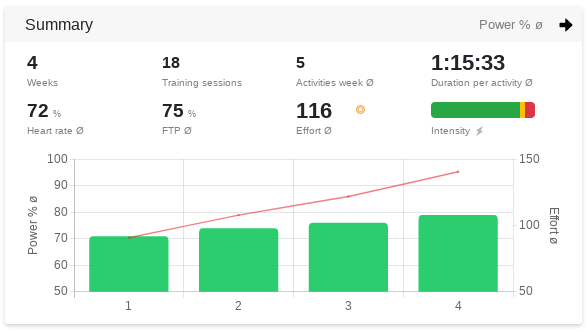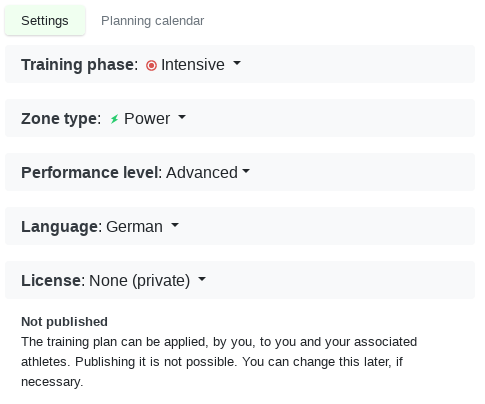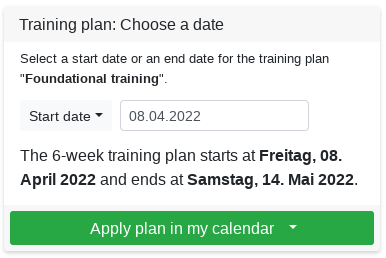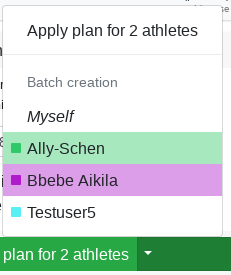If you have frequently recurring training patterns that you would like to reuse, or if you as a coach would like to use your self-created training plans with your athletes, including adjusting the capacity values, then you can now breathe a sigh of relief. Tredict has introduced a new category, you named it, called "Training plans".
You can create unpublished training plans as "private" or publish them in order to sell your training plans under the Tredict distribution licence or offer those plans under a "Creative Commons Licence".
Create training plan
In the subcategory "Training plans" -> "Create plan", you will find the view for creating a training plan.
The "Settings" tab contains all the metadata of your training plan. This means the attributes of the plan and the statistics, such as the number of workouts per week, the complete intensity distribution or the percentage of FTP to which the training plan is adjusted for. In addition, the "Planning calendar" is the actual place where you assign the individual training sessions to your training plan.

Statistics such as effort, workouts per week or intensity distribution.
The training plan sports are automatically determined from the training sessions used. The most used sport defines the main sport of the training plan. As usual in Tredict, running, cycling, swimming and many other sports are supported for the training plan. You can create a training plan for swimming by dragging the corresponding swimming sessions into the planning calendar or a training plan for running by creating mainly running sessions.
Training plan attributes
A training plan in Tredict has certain attributes that you have to specify when creating your training plan. You should therefore first think about what your training plan should be able to do, for which performance level it is intended and which training phases the training plan covers.
If you only want to set up recurring training patterns, perhaps over 10 days, then you certainly don't need to worry about this so much.

Attributes of the training plan, such as training phases, zone types and performance level.
Training phases
Training phases are a popular model for periodising a training season in competitive sports and sports science. In Tredict you can assign your training plan to one or more training phases.
General phase
You can select the general training phase if the training plan does not follow any specific training periodisation principles. Or you simply don't know how else to assign it. :-)
Foundation phase
The foundation phase takes care of the basic endurance of your endurance training and subsequently prepares the basis for further more specialised training phases.
Build-up phase
In the build-up or build phase, volumes are increased and specialised sessions are added. The build-up phase takes the momentum of the foundation phase, builds on it and leads purposefully to the intensive phase or the seasonal plateau.
Intensive phase
In the intensive phase of a training season, the main aim is to add speed to the already existing endurance. The distances remain high. High-intensity units and other special training sessions are regularly interspersed.
Pre-competition phase
Competition preparation is characterised by reduced circumferences and tapering. Sometimes special training sessions are added to increase efficiency.
Seasonal plateau phase
If you have many competitions in a row for which you have trained specifically, you are in the training phase of the season plateau. The strenuous competitions are given weight by sufficient recovery. The next competition is prepared for with training units that keep up the form.
Recovery phase
The recovery phase or off-season is used for long-term regeneration after the hard competition period. The distances and intensities are low.
Special phase
The special phase is a general special category for special training concepts, such as those found in ultramarathon training.
Performance levels
The performance levels of the training plan indicate for which athletes the training plan is suitable. You can choose whether your training plan is suitable for everyone, beginners, advanced or professionals.
Zone types
The zone types define which zones the training plan uses. So a mainly watt-based training plan should have "power" selected as the zone type, a training plan based on heart rate, the heart rate zone type and a training plan based on speed, the pace or tempo zones. Zone types can also be mixed. So your training plan may also be based on wattage and heart rate at the same time.
Planning calendar
The planning calendar is actually no different from what you are used to in your own training calendar. You can drag and drop e.g. heart rate based training sessions from templates or manually into the calendar. These can follow relative or absolute capacity values. The training plan then automatically calculates its statistics from the corresponding training units.
Apply training plan
When applying a training plan, the relative capacity values of the training sessions, such as wattage, heart rate and pace, automatically adjust to the capacity values of the current zone revision of the selected athlete.
To apply a training plan, select it in the subcategory "My plans" and then click on the green button "Apply training plan". Then enter either a start date or an end date for the training plan.
If the training plan ends with a competition, for example, then it makes sense to use the end date of the training plan as the end date of the competition.n.
To transfer the plan to your own training calendar, press the green button "Apply plan to my calendar". Tredict will then automatically calculate the correct training date for each training and copy it to your own training calendar. In addition, all capacity values of the training units are automatically converted to your own capacity revision. This concerns wattage, speed and heart rate.

The training plan is applied to your own calendar.
Multiple simultaneous application of a training plan
If you are a coach connected to several athletes, then you can apply a training plan or shorter training patterns, several times and in one go, into several calendars of your athletes at the same time. This can save you a lot of work and is a very powerful tool. But be careful, if you accidentally apply the wrong plan to 50 athletes at the same time, the clean-up will be fun, not! ;-)
If you have already used a training plan with an athlete, Tredict will tell you about it. In addition, in the training plan history you can see in tabular form how often and with whom the training plan has already been used.

Multiple application of a training plan.
Summary
With Tredict you now have a training plan and analysis for endurance athletes, where you can create and reuse your own training plans. When applying a training plan, the absolute capacity values, such as wattage, heart rate or speed, are automatically adapted to the athlete. A training plan can be applied to several athletes at the same time, which can be very helpful.
